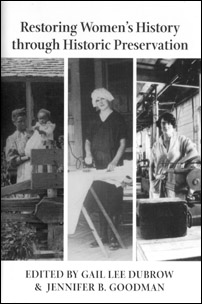Book Review
Restoring Women's History through Historic Preservation
Edited by Gail Lee DuBrow and Jennifer B. Goodman. Baltimore, MD: Johns Hopkins University Press, 2003; 428 pp., photographs, appendices, notes, index; cloth $49.95.
 |
This volume amply illustrates the unruly, untidy, and occasionally undisciplined practices required to reintroduce women into their natural habitat in historic landscapes and buildings dominated by stories about great men. The essays resemble a gathering of friends who know one another so well that they talk over each other, finish each other's sentences, and steal words from each other's mouths. Indeed, efforts to bring women's presence to the past have centered to date around a few well-connected, well-known leaders, who work diligently on their separate goals and come together every few years to learn from and support each other, and to discuss and plot new strategies and work. Restoring Women's History Through Historic Preservation reads like a cookbook for this first generation. It demonstrates that the time is ripe to move beyond the tight network of committed women's history preservationists, as well as to focus more carefully on what can be done in separate fields to support a "more democratic and inclusive vision" of historic preservation.
The field of historic preservation, where the relationship between disciplines contesting to document, preserve, and educate the public about history through the built environment can range from barren to very fruitful, is equally untidy. Curators, archeologists, landscape architects, and planners look for significance in physical evidence, while historians and ethnographers, familiar with oral and written tradition, use documentary evidence within broad historical themes. Lack of familiarity with written sources can lead to judging something as significant, which document-based scholars know to be a normative feature of a historic period, or to making conclusions that are unsupported either by the archeological record or by secondary sources. Meanwhile, document-based scholars regularly overlook or misread evidence of human activity in material culture, the landscape, and the built environment. Bringing disparate disciplines to bear on the role of women further complicates already tenuous connections.
Cultural resources professionals who have challenged the methods and theories of their respective fields to include gender as a basic category of analysis have had varying degrees of success, resulting in new work on women's history from several disciplinary perspectives. Site-based staff and policymakers who rely on this work to support their efforts to incorporate women's experiences in preserved landscapes, historic sites, and educational programs, may lack training to assess what they are reading. Restoring Women's History through Historic Preservation documents the last decade of efforts to return women's presence to historic sites and landscapes by reaching across multiple boundaries.
Featuring presentations from three national conferences between 1994 and 2000, as well as a few essays produced for the volume, Restoring Women's History aims to bring "the best work together under one cover." Nineteen selections are arranged in five parts: 1) surveying the work of women in historic preservation, 2) assessing interpretive strategies, 3) using resource or building type analysis as new primary sources about women's lives, 4) showcasing "exemplary" projects, and 5) evaluating Federal policy in the United States and Canada.
The structure occasionally obscures an essay's intent, as when a piece on preserving gay and lesbian sites in general is placed in the section on "exemplary projects" rather than in the section critiquing Federal preservation policy in the United States, or when chapters on preservation practice in Georgia and West Virginia are placed in different sections. This is exacerbated by the bane of conference proceedings: many selections have appeared elsewhere, overlap significantly, or reference the same organizations, sites, programs, conferences, events, and publications. One wishes for more editorial control over repetitious references and sections, and for a single bibliography to minimize wading through footnotes for each essay.
That being said, what a glorious conversation this book reveals! It embraces the history of nurses and librarians through the built environment, the folkways of Los Angeles prostitutes through archeological evidence, issues of gender in preservation practice, and strategies for reclaiming histories whose neglected buildings have been lost. The author list reads like a "who's who" of preservation in Canada and the United States, with essays by Carol Shull, Alan McCullough, Dolores Hayden, Page Putnam Miller, Patricia West, Edith Mayo, and more. If there is one book to have on your shelf about preserving women's history, this is it.
Yet there is much more work to be done. To date only a few States have comprehensively surveyed properties relevant to women's history, in spite of presidential and congressional mandates. (Leslie Sharp's essay on the Georgia survey provides a good model.) Evidence of women's experiences encoded in the built environment is underutilized. (Essays by Abigail Van Slyck on libraries and by Annmarie Adams on nurses' residences point the way.)
Telling the stories of women's lives at historic sites requires knowledge, patience, and supportive colleagues. Patricia West and Edith Mayo provide information and advice; Kim Moon discusses the project that provided a structure for statewide collaborative efforts in Pennsylvania; Allan McCullough and Carol Shull reflect on preservation policy in Canada and the United States, where divergent commemorative strategies illustrate that process can hinder or help efforts to include women.
Interestingly, this volume appears just as the National Collaborative for Women's History Sites gains its nonprofit status. The collaborative, fostered by several of the authors featured in Restoring Women's History Through Historic Preservation, is a membership organization that supports the agenda richly canvassed by this book.
Vivien Ellen Rose
National Park Service
